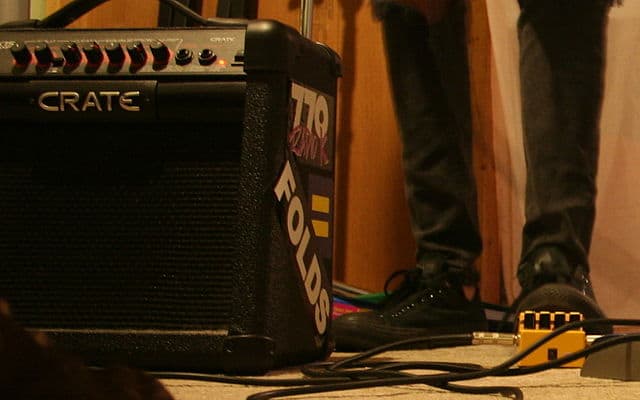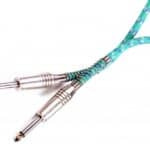Guitar amplifiers often have options for footswitches on the back panel that give you a hands-free way to let you change the sound of your playing.
But the footswitches themselves are sometimes sold separately or if you buy a used amp from a store there’s a good chance the footswitch has gone missing somewhere along the way.
So now you have a conundrum about how to get the most out of your amp, and trying a footswitch from another amp can be awfully tempting.
Unfortunately, amps interact with footswitches in different ways, and the footswitches themselves often use different types of switches, jacks, and cables. While it’s possible to find a different footswitch that works, don’t start plugging in an array of other footswitches without proper research or experience.
If your amp did come with a footswitch and it stopped working, I’m afraid that there is more bad news.
Something like a tube amp, for example, may have a warranty period of several years but the warranty on the tubes and footswitch may be much shorter, like 90 days.
I get it. It’s hard to provide a warranty on something that people literally step on.
And footswitches can be back-ordered sometimes so perhaps your best bet is to try to have it repaired or…maybe it’s time to look for an alternative?
How do amp footswitches work?
For this article, we will just be focusing on footswitches that use (instrument) cables with TS (tip sleeve) or TRS (tip ring sleeve) plugs.
If an amp has any kind of complicated or proprietary cable for the footswitch then you have to use the manufacturer’s footswitch and cable or aftermarket ones specifically designed as exact replacements.
Furthermore let’s limit our discussion to footswitches that don’t use active circuitry and that have no more than two or three switches, such as reverb on/off, channel switching, and boost on/off.
So for a footswitch that uses a TS-style plug, pressing the switch closes the connection between the two parts of the plug, sending a signal to the amplifier.
It sounds simple but there’s more to it, depending on what the amp does with that information.
Do all amp footswitches work the same?
The first hurdle to jump is knowing if the footswitch uses mono (TS cables) or stereo jacks (TRS cables).
If you can’t find the information online, you can probably look inside the jack with a well-focused flashlight to see if there are two or three metal contact points.
Then you need to determine whether the footswitch makes use of momentary or latching connections.
If it is momentary, then closing the connection briefly will change the channel or turn on the reverb, etc.
For latching, you have to maintain a closed circuit.
You can see how this works on a functioning footswitch if you know how to use the resistance measuring tool on a multimeter.
Working backward from this example, you can plug an instrument cable into your amp’s footswitch jack and short the connection between the tip and sleeve (or ring and sleeve if it is a stereo jack/cable) with a piece of metal.
You can thus figure out if it needs momentary or latching switches.
In other words, if the function changes with a quick touch and stays changed, then it is momentary.
If the function reverts back when you break the connection then consider it to be latching.
Are guitar amp footswitches universal?
So the cold hard truth is footswitches are very far from being universally swappable between amps.
It was probably more common in the past as amp circuits and features were simpler.
For instance, I once had an old Univox tube amp that didn’t have the footswitch but I was able to use a generic one for switching the tremolo circuit on and off.
So in some cases, I know from personal experience that it is possible.
But with the rise of things like 3 (or more) channel amps with onboard effects, digital modeling, and programmable amps with many different amp models, the pedals will also undoubtedly be more complex.
Line 6 Floorboards are a good example of this.
So if the amp that you need a footswitch for is a complicated affair and the original isn’t manufactured anymore then you should see if there are aftermarket clone replacements available.
What are amp brands known for having interchangeable footswitches?
Obviously, brands want you to buy their accessories; so it isn’t in their best interest for their footswitches to play nicely together with other companies’ amps.
And since each brand offers so many models, it complicates things even more so that you basically just have to get lucky.
Now, two companies that do come to mind though are Roland and Boss, since they are under the same management and Boss makes the footswitches to be used with both brands.
And if your amp’s switching needs are simple, I will at least mention some of Boss’s products such as FS-5U (single switch, unlatching), FS-5L (single switch, latching), and FS-6 (dual footswitch with latching / unlatching and 2 mono or one stereo jack)
These models also have polarity switches that may be helpful, for coordinating the LED indicators I guess.
On the downside, some of these require 9v batteries to operate (no power supply option) and they are expensive but Boss products are usually very sturdy and they might fit your needs if you can determine what kind of footswitch you need.
There are also some cheaper brands such as Hosa, HOTONE, and HQRP (for Peavey amps) that produce common footswitches for famous amps.
Other than that I would recommend checking out musician forums, and footswitch product reviews (“I got this to see if it would work with my “whatever” amp and it works great”), and asking experienced salespeople at music stores if they have a recommendation.
One more great option is if you take an amplifier to a repair shop to have it serviced or retubed, see if the repair techs have any pedal compatibility knowledge for it while you are already there as a paying customer.
Will a non-amp footswitch work on a guitar amp?
There are cases where a “non-amp” footswitch could work for amps, especially older amps, as long as the momentary / latching style has been matched.
Now a pedal that re-routes a signal such as an A/B/Y switch wouldn’t work and of course, a volume swell pedal wouldn’t work (as far as I know!), but you could certainly build your own footswitch pedal in some cases.
Of course with the high retail cost of individual parts and shipping, it might cost as much as buying a whole footswitch though.
But the point is, a homemade footswitch could be considered a non-amp footswitch, couldn’t it?
After all, like the method of determining whether an amplifier needs a momentary or latching switch, you can switch functions on some amps with nothing more than an instrument cable and a paper clip.
Can there be any issues if your footswitch and amp’s brands don’t match?
In a perfect world, things wouldn’t break or get misplaced, you would always have the original footswitch for your amp, and you would look cool and fashionable.
And while so many footswitches aren’t cross-compatible, if you are able to find one that is, even though it is from a different brand, you should congratulate yourself.
Unless you’re worried that your bandmates will make fun of you because the brands don’t match.
If that’s the case I think that maybe you should find some new bandmates.

Hello there, my name is Ramiro and I’ve been playing guitar for almost 20 years. I’m obsessed with everything gear-related and I thought it might be worth sharing it. From guitars, pedals, amps, and synths to studio gear and production tips, I hope you find what I post here useful, and I’ll try my best to keep it entertaining also.





